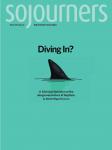THE LAST GUN-MURDER massacre in Australia happened in April 1996.
I remember it clearly. My wife and I were preparing to move from our home in Sydney to California, where I’d been accepted to study at Fuller Theological Seminary. After 13 years of a Labor government in Australia, Conservative John Howard had just been elected prime minister. My wife and I joked that it was a good time to leave the country. Then the Port Arthur massacre occurred—35 people were killed, 23 were wounded.
What happened next was astounding. The senior leaders of both major political parties, at both the federal and state levels, faced down opponents and enacted far-reaching and effective new gun laws.
What came to be called the National Firearms Agreement banned the importation, sale, and possession of all automatic and semi-automatic rifles and shotguns (most handguns were already illegal) and enacted a compulsory gun buy-back scheme.
The new agreement for gun ownership allowed guns to the military, police, and those employed to shoot feral animals. The new federal laws were enacted unilaterally across state rights. Controversially in light of Second Amendment rights in the U.S., the act specifically stated “that personal protection not be regarded as a genuine reason for owning, possessing, or using a firearm.” However, genuine reasons included “sporting shooters” with valid club memberships, hunters with proof of permission, and “bona fide collectors of lawful firearms.”
The new gun laws were passed quickly, accompanied by an amnesty for any unlicensed firearms.
As we packed our bags to move to the United States, images filled the nightly television news of police stations across Australia full of firearms of varying shapes, sizes, and states of legality. These were guns that were voluntarily surrendered, in addition to those gathered through the formal buy-back program. It was more than politics. It was a national moment.
Somehow, without political coercion or public commentary, Australians decided that gun ownership should become marginal, not mainstream. The legislation merely reflected the national mood: Only soldiers, cops, and farmers needed to own guns. The mythos of the historical outlaw-hero, like bushranger Ned Kelly, remained. However, like Kelly, gun ownership was now part of Australia’s past, not our future.
Shortly before boarding our flight to the California, I suggested to my father that an old shotgun the family possessed—passed down through three generations, but rarely fired in more than 50 years—might be surrendered during the amnesty. I was too late. He had already handed it in a month earlier, without consultation—even though the gun really belonged to me as the firstborn son! My momentary indignation passed and I’ve thought rarely about my forfeited birthright since.
Since my wife and I returned to Australia in 1998, I have worked as an Anglican priest in Sydney’s inner-city neighborhoods. Alternatives to violence, I’ve learned, are often more popular with street-involved people than with my educated, middle-class peers. From the streets I’ve gained perspective about the justice of Jesus Christ: a justice that reconciles, a justice that renounces retaliation, a justice with repentance, and a justice with repair.
The Port Arthur massacre changed Australia. My teenage children are spared the horrific gun violence experienced in the U.S. “I feel free because we are not always in lockdown, worried about people coming into the school,” Nick, age 14, told me. Anna, age 12, said the freedom to go unafraid to the local park with friends was an important difference between growing up in Australia vs. the U.S.
In Australia, we will continue to pray for you in America: for courageous politics, for a “national moment,” for Americans to decide that gun ownership should be marginal, not mainstream.

Got something to say about what you're reading? We value your feedback!

